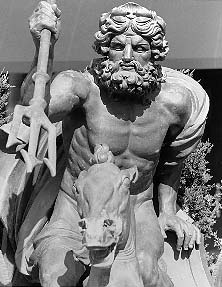The Silhouette Syndrome
 Thursday, June 28, 2007 at 05:19PM
Thursday, June 28, 2007 at 05:19PM ![images[49].jpg](/picture/images[49].jpg?pictureId=732031&asGalleryImage=true) A silhouette appears when light shines on everything except the actual subject. The profile that emerges yields ample visual clues so viewers can tell whether an object is a bird, a plane or a flower. If silhouettes depict persons with well-known images, like George Washington or Abraham Lincoln, they may be easily recognized, even though no direct lighting shines on the person’s face. In elementary schools around the country, nearly every holiday finds kids in art classes scissoring turkeys, Santas or Lincoln profiles out of black construction paper and pasting them onto lacy white backgrounds. Subtle, yet stark, demure, yet enlightening, silhouettes intrigue us. The absence of light can be as revealing as its presence.
A silhouette appears when light shines on everything except the actual subject. The profile that emerges yields ample visual clues so viewers can tell whether an object is a bird, a plane or a flower. If silhouettes depict persons with well-known images, like George Washington or Abraham Lincoln, they may be easily recognized, even though no direct lighting shines on the person’s face. In elementary schools around the country, nearly every holiday finds kids in art classes scissoring turkeys, Santas or Lincoln profiles out of black construction paper and pasting them onto lacy white backgrounds. Subtle, yet stark, demure, yet enlightening, silhouettes intrigue us. The absence of light can be as revealing as its presence.
Art project silhouettes are one thing. Silhouettes that show up in when we decline to shine the light of truth on people and events are something else. For example, as citizens, we become outraged when law enforcement officers “look the other way” while patrolling crime infested neighborhoods and allow prostitution and drug dealing to go down in plain view. We complain bitterly at judges who let DUI offenders off the hook, permitting them to get behind the wheel of another car and risk the life of yet another innocent bystander. We berate legislators who engage in pork barrel politics. We soundly criticize elected officials whom we send to congress or the White House to do certain things, and, once they arrive, they forget why they’re there and espouse other causes. They may not realize it, but they send a truer picture of their core values to their constituents by their silence than by their noise.
Many years ago, British statesman Edmund Burke said “All that is necessary for the triumph of evil is that good men do nothing.” Others have further observed that good men who do nothing, in fact, may not be good. James 4:17 says, “Therefore to him that knoweth to do good, and doeth it not, to him it is sin.” Failure to do good creates a hole, a vacuum of righteousness, a deafening silence, a blinding darkness. The Levite and the priest who crossed to the other side of the road to avoid contact with the wounded traveler may have been able to write or speak at length on caring for the sick. The work that they hastened to do may have been noble and necessary. Their failure to do something good at a critical moment, however, accurately portrayed the content of their hearts. What they didn’t do has made a far more lasting impression of their characters over the centuries than anything they did. Afterwards, they may have felt unfairly judged. After all, they didn’t do anything wrong…they just chose not to do something right. But, that’s the point, isn’t it? The legacy of a hard heart, an uncaring spirit—-or even an apostate mind—-forms in the wake of those who simply decline to act.
Those who love truth will not flee the flak of opposition to retreat into the safe grayness of doctrinal silence. Yes, definitive teaching, bold declarations and staking out strong positions on what people ought to believe and how they ought to live make many feel uncomfortable, but that’s often what God calls us to do. Imagine if doctors vowed only to share good news with their patients. Imagine if contractors schemed to hide the negatives and talk only about the positives of a proposed building project. Likewise, if we key only on safe subjects that make few waves, we abdicate our responsibility. We cannot do some good things, but omit others, thinking that the commissions compensate for the omissions. We cannot preach some truths, but leave out others, thinking that the good things we say make up for the good things we don’t say. We reveal our true interests and thought patterns through our negatives as much as our positives. This is precisely what Jesus referred to when he said, “Woe unto you, scribes and Pharisees, hypocrites! for ye pay tithe of mint and anise and cummin, and have omitted the weightier matters of the law, judgment, mercy, and faith: these ought ye to have done, and not to leave the other undone.” Matthew 23:23. In his inimitable way, Jesus charged them with skewed judgment, hardness of heart and faithlessness, and they didn’t even know they were being razor-bladed so brilliantly. Undone matters broadcast loudly the default values of our hearts. Pentecostal sage T. F. Tenney says, “Anything that goes unpreached will soon go unpracticed.”
The Apostle John writes, “That which we have seen and heard declare we unto you, that ye also may have fellowship with us…And these things write we unto you, that your joy may be full.” 1 John 1:3-4. The Apostolic movement did not arrive at its present strength by not doing right things or not fully preaching the doctrine of the Apostles. We have received our legacy from fearless pioneers who were not victimized by the silhouette syndrome. We know what we believe today because they knew what they believed and they proclaimed it loudly and with great conviction. The church cannot move forward on a default message built on cowardice. Let’s turn on the light.


![6-13a_head_of_christ[1].jpg](/picture/6-13a_head_of_christ[1].jpg?pictureId=733563&asGalleryImage=true)

![azusamission-thumb[1].jpg](/picture/azusamission-thumb[1].jpg?pictureId=727107&asGalleryImage=true)
![paris-las-vegas-14.3[1].jpg](/picture/paris-las-vegas-14.3[1].jpg?pictureId=730316&asGalleryImage=true)

